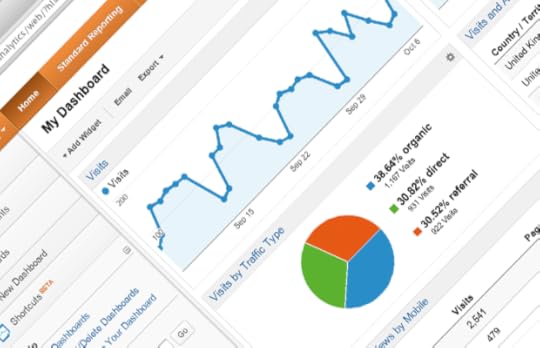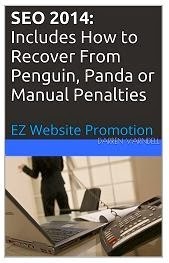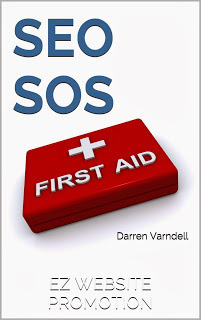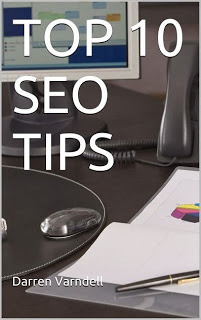Darren Varndell's Blog, page 3
January 7, 2014
Planning Web Pages
 Planning your Web PagesThe first thing to consider when planning the pages for your website is the structure that your website will take. When a user types your domain name only (no file or path specified) into a browser, e.g. www.example.com, they will be shown the default index page for the website.
Planning your Web PagesThe first thing to consider when planning the pages for your website is the structure that your website will take. When a user types your domain name only (no file or path specified) into a browser, e.g. www.example.com, they will be shown the default index page for the website. This default page should be your starting point with all additional pages linked from here. This file is usually named index.html or default.html (or similar) and should be created in the top root directory of your website. Check with your web hosting provider for the correct default filename used on your web hosting platform as this varies from provider to provider.
You should define exactly what information you wish to appear on this main index page, and what other information you wish to include on one or more additional pages that you will create. A user visiting your site will navigate among these pages using a menu, navigation bar, or other links you add to your pages.
A typical example of a basic business website structure might be something like;
Home page (main Index) containing basic company info with links to additional pages:About page containing detailed company information.Products page(s) listing your services or products for sale.Contact page listing location, phone number and email address (or contact form).Terms & Conditions page showing your conditions for use of your website and terms of business.Privacy Policy page stating how you use information obtained via your website and other privacy related issues.
You would obviously add (or remove) pages to fit your particular needs, but with the example above it would seem appropriate to create a menu or navigation bar with the following links:
Home – Products - About – Terms – Privacy - Contact
Each of these pages must be created individually and given unique filenames. In the case of the main index page (often called the home page) our file name is already set for us, in most cases 'index.html', however the additional files you will create should be given meaningful names such as products.html, about.html, terms.html, and so on. Also be sure to include your targeted keywords in page file names where relevant..
Once created and placed on your server, your web page can be accessed via the web using a combination of your domain name and the unique filename. In our example above we could access our products page directly by typing www.example.com/products.html into our browser. You would also make the word 'Products' in your menu or navigation into a hyper link, that when clicked upon, will move the users browser to that page.
 Want to know more? This article is a excerpt from our popular SEO Book: SEO SOS, available in both Print and eBook format from Amazon.
Want to know more? This article is a excerpt from our popular SEO Book: SEO SOS, available in both Print and eBook format from Amazon..
Published on January 07, 2014 09:28
January 6, 2014
Keyword Research SEO
 Keyword ResearchKeyword research is probably the single most important task that you will undertake with regards to your Internet marketing. Long before getting to work creating your website you will need to identify your target market. If you are experienced in the world of business you may well already understand this concept as the identification of the people you will try to sell your product or service. When it comes to marketing a website there is another vital layer that is just as important, to research your target keywords.
Keyword ResearchKeyword research is probably the single most important task that you will undertake with regards to your Internet marketing. Long before getting to work creating your website you will need to identify your target market. If you are experienced in the world of business you may well already understand this concept as the identification of the people you will try to sell your product or service. When it comes to marketing a website there is another vital layer that is just as important, to research your target keywords.Keywords play an important role within Internet marketing as they help identify a particular topic or niche for a given web page or resource; for example if you were to pay to advertise your website on other sites on the web, you may well only want your advertisement to appear on pages related to the product or service that you offer. Most advertising agencies allow you to target your ads to specific keywords. If we wanted to advertise our car parts website we might opt for targeting sites that contain the word "car", "car parts", "motor parts" etc.
When developing your own website, keywords play an even bigger role. As most web traffic originates from search engines it would make sense to make our website perform as well as possible within these search engine result pages for people looking for our type of product or service, and the key to this is proper keyword research.
The first step is to identify the top words and phrases that not only relate to your services, products, business or brand, but those phrases that users are likely to actually type into a search engine when looking for the type of products or services that you offer.
Start by identifying two or three top keyword phrases that are used to search for your type of website. A keyword may be a single word, e.g. "cars", or contain several words, often referred to as long tail keywords, e.g. "Used car parts". Targeting long tail keywords is usually more effective as they have a more refined scope combined with less competition.
If your type of business is location based, as in our previous pizza delivery example, you would most certainly want to include your location (city, town, county etc.) among your targeted keywords.
All of your selected keywords must be related to your business or niche. The use of unrelated keywords within your web pages can cost you penalties in the search engines and also make your site look spammy and unprofessional.
Taking some time to get this right from the start will pay significant dividends and put your business on the fast track to Internet success.
 Want to know more? This article is a excerpt from our popular SEO Book: DIY SEO & Internet Marketing Guide, available in both Print and eBook format from Amazon.
Want to know more? This article is a excerpt from our popular SEO Book: DIY SEO & Internet Marketing Guide, available in both Print and eBook format from Amazon..
Published on January 06, 2014 04:32
Successful Online Business
 Create a Successful Online BusinessThe main ingredients for creating a successful online business would start with the creation of a quality, well planned, user friendly website. A website is a term given to a collection of interactive web pages that can be accessed via the Internet using a web browser (a computer software program for displaying and navigating web pages).
Create a Successful Online BusinessThe main ingredients for creating a successful online business would start with the creation of a quality, well planned, user friendly website. A website is a term given to a collection of interactive web pages that can be accessed via the Internet using a web browser (a computer software program for displaying and navigating web pages).To make these pages available on the internet they must be placed on to a web server, a computer running special software with the task of providing access to these, and other pages available on the server, to people surfing the internet.
Many companies offer web hosting services that allow you to upload your website pages and make them available on the Internet. Whilst you may be tempted to opt for one of the many free web hosting options available on the web you should avoid this temptation as these services are usually over-subscribed, often contain advertising, and as you will discover more in this book, could give negative quality signals to search engines. Web hosting packages start at only a few bucks, can be tailored to meet your needs, and also take care of the server side technical setup. In most cases you only need to know how to upload (transfer) your files to the server.
How you upload your files to your web space varies from provider to provider. In some instances they may offer a web interface that you can access with your web browser to upload your files. In other cases your provider may expect you to upload your web pages and other associated files using FTP (File Transmission Protocol). To transfer your files using FTP requires the use of an FTP Client, a software program readily available to download for free, or purchase, from numerous sources on the web.
Once your pages are uploaded to your web space, and your website is available on the World Wide Web, the next task would be to make it's existence known to the world using various online and offline marketing techniques. A failure to properly address these various tasks is the most common reason for many businesses failing to establish a presence online, depriving them of the opportunities that this global and expanding market has to offer.
The key to success is to tap into the source of the largest flow of internet traffic, and turn that traffic (website visitors) into leads and sales. Here is the good news; this huge source of traffic and potential sales is Search Engines, in particular, the top three, namely Google, Bing and Yahoo respectively. The largest alone deals with over 100 billion searches per month, which is an astounding figure. To state this is a massive market would be an understatement.
The better news; if you follow the steps and adopt the core concepts and principles outlined in this book, a constant share of that free traffic and potential sales can be yours, for FREE!
Creating a Search Friendly WebsiteIn order to tap in to this incredible flow of free website visitors from search engines it is necessary to construct (or edit) our website to make it Search Engine Friendly. By placing certain vital information (keywords) in the right quantities, into various locations within our website, we can help search engines identify the topic of our site, with the aim of positioning our website within the first few results shown when a user searches for our type of product or service.
For example, if we were marketing a website for a Pizza delivery business based in New York, we would want to be found within the first few results on major search engines when a user searches for a phrase such as ‘New York pizza delivery’. Reaching the number one position for a relevant search will ensure a steady stream of free targeted visitors to your website, all ready for you to turn them into sales.
The tasks involved in making a website and web pages search engine friendly are usually referred to Search Engine Optimization, or SEO for short. With the largest search engine, Google, using in excess of two hundred signals to decide upon a websites topic and relevance, the world of SEO can seem a daunting area at first.
However, not all of these signals are equal, with this manual cutting through the minefield of search optimization and presenting some insight into the most critical areas of optimization that need to be addressed on your website, concentrating on the main aspects that produce the best results and biggest impact on your search engine rankings (the position your site appears in search results).
 Want to know more? This article is a excerpt from our popular SEO Book: DIY SEO & Internet Marketing Guide, available in both Print and eBook format from Amazon.
Want to know more? This article is a excerpt from our popular SEO Book: DIY SEO & Internet Marketing Guide, available in both Print and eBook format from Amazon..
Published on January 06, 2014 04:25
December 31, 2013
SEO 2014 - FREE SEO Book
 FREE SEO Book: SEO 2014SEO 2014: Includes How to Recover From Penguin, Panda or Manual Penalties (EZ Website Promotion Series)
FREE SEO Book: SEO 2014SEO 2014: Includes How to Recover From Penguin, Panda or Manual Penalties (EZ Website Promotion Series) In the first section of this SEO book, healthy and effective Search Engine Optimization practices are discussed to help your website rank higher, and secure a steady stream of FREE Traffic, while avoiding potential penalties that could be placed on your site for a breach of the search engine rules and guidelines.
Later, this book examines recent important search engine updates that could have had (or will have) a negative impact on your 2014 website rankings and beyond, along with corrective strategies for website recovery after a hit from Panda or Penguin updates.
Finally, SEO 2014 takes a look at the process of identifying and recovering from Manual actions that could be placed against your website by Google’s Web Spam Team if you, or someone working on your behalf (SEO consultant etc), has employed unethical black hat techniques in the past.
Now, more than ever, quality on-page search optimization is critical to obtaining high search rankings, alongside quality content and the end-user experience. SEO 2014 brings this information to you in a direct and easy to understand way, arming you with the tools required to climb the search rankings and significantly boost your website traffic.
To celebrate the launch of this new book we are giving away the Kindle ebook version of this resource completely FREE for the next 5 days only. Don't delay, get your copy today!
GRAB YOUR FREE COPY HERE: SEO 2014
Don't have a Kindle device? You can also get the FREE Kindle e-reader software to run on most Desktop and Mobile platforms. You can also obtain SEO 2014 in Print, delivered direct from Amazon.
Published on December 31, 2013 06:29
December 21, 2013
Search Engine Optimization First Aid Guide
 Happy Holidays! Have a Gift on us...
Happy Holidays! Have a Gift on us...As a special thank you to our readers for a last year of support, we are offering the Kindle version of our New book; 'SEO SOS: Search Engine Optimization First Aid Guide', absolutely FREE until the end of Christmas Day.
Feel free to share this gift with your friends, but hurry, this offer ends at midnight on Christmas night.
Download today direct from Amazon.com and Amazon.co.uk
You can also get the Paperback version of SEO SOS: Search Engine Optimization Guide at Amazon.
Book detailsSEO SoS uses a tongue-in-cheek 'First Aid Guide' approach to address Website Search Engine Optimization health issues that could have a negative effect on your site rankings in Search Engines.
Boost Website Traffic and Sales by performing some simple Search Optimization techniques on your web pages to achieve higher rankings, and an increased flow of targeted traffic to your website!
See full details of this publication on the SEO SOS Guide information page.
Published on December 21, 2013 09:55
December 16, 2013
SEO Christmas song - Jingle bells cover "Analyze Optimize"
MERRY CHRISTMAS!
 Lyrics for the SEO Christmas song (Jinge bells cover):Dancing through the SERPs,
Lyrics for the SEO Christmas song (Jinge bells cover):Dancing through the SERPs, keywords are on their way.
To the top we go,
is were we want to stay.
Sourcecode clean and smooth
H1 is in its place.
Let's go longtail and begin on a new landing page
Analyze optimize,
need I say it twice?
Spam and black-hat cloaking
are not choices that are wise
Analyze optimize,
what is the grand price?
Getting tons of traffic,
oh you won't believe its size
You know what Santa says
that good content is king.
If you please your users
more traffic it will bring.
Yes Google+ is new,
but please don't leave it blank.
Let's get social and begin improving AuthorRank.
Analyze optimize,
we just want to rise
Traffic and convertions
reaching record-breaking heights.
Analyze optimize,
Begin to Googlize
Soon you'll see your S-E-O
starts to monetize
Be aware of Panda
pages cannot be thin.
If you build spammy links
you'll get hit by Penquin
Fix duplicate content
although it seems complex
You may set meta-robots to nofollow, noindex
Analyze optimize
Santa never flies,
with his sleigh unless his route
with Google Maps complies
S-E-O never dies
just a kind advice
So have a merry Christmas and then start to optimize.
http://www.youtube.com/watch?v=CKml_LYrna0&hd=1
Published on December 16, 2013 14:00
December 13, 2013
Top 10 SEO Tips - FREE eBook
 FREE EBOOK - Top 10 SEO Tips
10 Top SEO Tips
to Boost Website Traffic
FREE EBOOK - Top 10 SEO Tips
10 Top SEO Tips
to Boost Website Traffic SEO (Search Engine Optimization) has become a crucial part of Internet Marketing to ensure that your website is easily found by potential new customers, so we have put together a Top 10 SEO Tips checklist to help you get the best search results for your website or online business.
Operating an online business website or e-commerce store, requires your website to be easily found in the major search engines. Just as retail stores try to get the best operating location, websites need to rank well in search engine results to be successful.
These Top 10 SEO tips are simple but highly effective techniques that can be used to improve your website search engine rankings to boost traffic, and ultimately, sales.
Check out our other SEO & Internet Marketing Publications.
Published on December 13, 2013 04:15
December 4, 2013
2014 SEO DIY and Internet Marketing Guide
NEW 2014 SEO & Internet Marketing Guide
 Are you one of the many webmasters feeling frustrated by the lack of income being produced by your website or blog? Do you want to make money from your website but struggle to get enough traffic (visitors) to do so? The problem could be easily fixed!
Are you one of the many webmasters feeling frustrated by the lack of income being produced by your website or blog? Do you want to make money from your website but struggle to get enough traffic (visitors) to do so? The problem could be easily fixed!
By simply making the right changes to your website and web pages you can dramatically improve your Search Engine Rankings and benefit from the steady flow of regular FREE Traffic that a good position in search result pages has to offer.
The DIY SEO & Internet Marketing Guide (2014 Edition) offers a series of easy to follow, step by step How to guides, SEO tips and tricks and a host of other insider secrets to help you Boost your Website Rankings and earn more money!
Available in both Print (paperback) and a variety of eBook formats for most platforms, from a variety of online distributors as shown below.
eBook Versions
 The ePub version of the DIY SEO & Internet Marketing eBook is available from
LULU.com
and other outlets, compatible with ereaders for Apple IOS (iPhone, iPad etc), Windows PC, Mac and other platforms. Also available in PDF Format.
The ePub version of the DIY SEO & Internet Marketing eBook is available from
LULU.com
and other outlets, compatible with ereaders for Apple IOS (iPhone, iPad etc), Windows PC, Mac and other platforms. Also available in PDF Format.
 The Kindle version of DIY SEO and Internet Marketing Guide is available from Amazon.com for Kindle devices, and for use on Kindle eBook reader software available for most platforms.
The Kindle version of DIY SEO and Internet Marketing Guide is available from Amazon.com for Kindle devices, and for use on Kindle eBook reader software available for most platforms.
Print Version
 Get the printed Paperback version of DIY SEO & Internet Marketing Guide: How To Do It Yourself Search Engine Optimization and Internet Marketing, direct from Amazon.co.uk and Amazon.com.
Get the printed Paperback version of DIY SEO & Internet Marketing Guide: How To Do It Yourself Search Engine Optimization and Internet Marketing, direct from Amazon.co.uk and Amazon.com.
 Grab a great 10% Discount on the retail price of the printed Paperback copy of DIY SEO & Marketing Guide direct from our publishers, Lulu.com.
Grab a great 10% Discount on the retail price of the printed Paperback copy of DIY SEO & Marketing Guide direct from our publishers, Lulu.com.
 Are you one of the many webmasters feeling frustrated by the lack of income being produced by your website or blog? Do you want to make money from your website but struggle to get enough traffic (visitors) to do so? The problem could be easily fixed!
Are you one of the many webmasters feeling frustrated by the lack of income being produced by your website or blog? Do you want to make money from your website but struggle to get enough traffic (visitors) to do so? The problem could be easily fixed!By simply making the right changes to your website and web pages you can dramatically improve your Search Engine Rankings and benefit from the steady flow of regular FREE Traffic that a good position in search result pages has to offer.
The DIY SEO & Internet Marketing Guide (2014 Edition) offers a series of easy to follow, step by step How to guides, SEO tips and tricks and a host of other insider secrets to help you Boost your Website Rankings and earn more money!
Available in both Print (paperback) and a variety of eBook formats for most platforms, from a variety of online distributors as shown below.
eBook Versions
 The ePub version of the DIY SEO & Internet Marketing eBook is available from
LULU.com
and other outlets, compatible with ereaders for Apple IOS (iPhone, iPad etc), Windows PC, Mac and other platforms. Also available in PDF Format.
The ePub version of the DIY SEO & Internet Marketing eBook is available from
LULU.com
and other outlets, compatible with ereaders for Apple IOS (iPhone, iPad etc), Windows PC, Mac and other platforms. Also available in PDF Format. The Kindle version of DIY SEO and Internet Marketing Guide is available from Amazon.com for Kindle devices, and for use on Kindle eBook reader software available for most platforms.
The Kindle version of DIY SEO and Internet Marketing Guide is available from Amazon.com for Kindle devices, and for use on Kindle eBook reader software available for most platforms. Print Version
 Get the printed Paperback version of DIY SEO & Internet Marketing Guide: How To Do It Yourself Search Engine Optimization and Internet Marketing, direct from Amazon.co.uk and Amazon.com.
Get the printed Paperback version of DIY SEO & Internet Marketing Guide: How To Do It Yourself Search Engine Optimization and Internet Marketing, direct from Amazon.co.uk and Amazon.com.  Grab a great 10% Discount on the retail price of the printed Paperback copy of DIY SEO & Marketing Guide direct from our publishers, Lulu.com.
Grab a great 10% Discount on the retail price of the printed Paperback copy of DIY SEO & Marketing Guide direct from our publishers, Lulu.com.
Published on December 04, 2013 10:34
September 11, 2013
SEO Internet Marketing Glossary
 SEARCH ENGINE OPTIMIZATION GLOSSARY OF TERMSShown below is a useful glossary of common terms used in the Search Engine Optimization (SEO) and Internet Marketing industry.
SEARCH ENGINE OPTIMIZATION GLOSSARY OF TERMSShown below is a useful glossary of common terms used in the Search Engine Optimization (SEO) and Internet Marketing industry.301 Redirect :: A permanent server redirect of a web page address often found in the htaccess file on apache servers, or within server side scripts. Also useful for dealing with duplicate content issues.
Adwords :: Google's pay per click contextual advertisement program, a common way of basic website monetization and advertisement.
Affiliate :: An affiliate site markets products or services that are actually sold and delivered by another website or business in exchange for a commissions or other benefits.
Algorithm (algo) :: A system used by search engines to determine what pages to suggest, and in what order, for a given search term or query.
Alt text :: A text description of a graphic, usually not shown to the end user, unless the image is not available, or a browser is used that does not support images. Alt text is important because search engines cannot read images and rely on this text to obtain an accurate description for the graphic object.
Analytics :: A program that assists webmasters in gathering and analyzing data about website usage and trends. Google analytics is a feature rich, free analytics program.
Anchor text :: The visible, clickable text of a web page link. Search engines use anchor text to indicate the relevancy of the referring website, and the link to the content on the target page. Ideally all three will have some keywords in common.
Authority (trust, link juice) :: The amount of trust that a website is given for a particular search term or query. Authority is derived largely from related incoming links from other trusted authority sites.
Authority site :: A website that has many incoming links from other related hub sites. Because of this simultaneous citation from trusted expert sites and hubs, an authority site usually has high trust, pagerank, and search results placement.
Backlink (back link, incoming link) :: Any incoming link to a page or website from any other page or site.
Black hat :: Non-ethical search engine optimization techniques that are counter to establish best practices such as the Google Webmaster Guidelines. Link spam and keyword stuffing are good examples.
Blog (weblog) :: A website that often presents content in a chronological way. Content may, or may not, be time sensitive. Most blogs use a Content Management System rather than individually crafted pages. Because of this, the Blogger can concentrate on content creation
instead of coding.
Bot (robot, spider, crawler) :: A program or application that performs a task autonomously. Search engines use bots to find, read and add web pages to their indexes.
Bounce rate :: The percentage of users who enter a site and then leave it without viewing any other pages.
Bread crumbs (breadcrumbs) :: A type of web site navigation, usually in a horizontal bar above the main content, that helps the user to understand where they are in relation to other pages on the site.
Canonical issues (duplicate content) :: It is often nearly impossible to avoid duplicate content, especially with the use of CMSs, but also due to the fact that www.xyz.com, xyz.com, and www.xyz.com/index.htm are often seen as duplicates by the SEs. These issues can be dealt with in several ways including; the use of the noindex meta tag in the non-canonical copies, and 301 server redirects to the master.
Click fraud :: Clicks on a PPC ad, usually by the publisher or his friends, for the purpose of undeserved profit.
Cloak :: Delivering different content to a search engine spider than a human user. This black hat technique is frowned upon by the search engines, and where detected could result in a virtual death penalty of the site/domain being banned fro SERPs.
CMS :: Content Management System - Programs such as Wordpress, which separate most of the Webmaster tasks like coding from content creation so that a publisher can create content without acquiring any specialist coding skills.
Code swapping (bait and switch) :: Changing the page content after a high search engine ranking is achieved.
Comment spam :: Posting blog comments for the purpose of generating an link to another site. The reason many blogs now use nofollow links.
Content (text, copy) :: The part of a web page that is intended to have value for the end user. Ads, navigation, headers, footers and branding are not usually considered as content.
Contextual advertisement :: Advertising that is related to the topic of the page content in which it is shown.
Conversion (goal) :: Achievement of a specific goal on a website. Ad clicks, sign-ups, and sales are examples of conversions.
Conversion rate :: Percentage of users that convert - See conversion.
CPC :: Cost Per Click - the rate that is paid per click on a Pay Per Click Advertisement.
CPM :: Cost Per Thousand impressions - A metric used to quantify the average value and cost of Pay Per Click advertisements. 'M' taken from the Roman numeral for one thousand.
Crawler (bot, spider) :: A program that navigates through the web, or a website, using links to gather data on the content it encounters.
Directory :: A site devoted to directory listing pages. The Yahoo directory and DMOZ (open directory project) are examples.
Directory page :: A page containing links to related or categorized web pages and websites.
Doorway (gateway) :: A web page that is designed specifically to attract high levels of traffic from a search engines.
Duplicate content :: Content that is similar, or identical to, the content found on another website or web page. A site serving duplicate content may well receive little, if any, trust from search engines compared to the content that the SE considers to be the original.
E-commerce site :: A website devoted to online retail sales.
Feed :: Content that is delivered to the user via special websites or programs such as news readers.
FFA (Free For All) :: A website with many outgoing links to unrelated sites, that contain little, if any, unique content. Only intended for spiders, and have little value to human users, and so are often ignored or penalized.
Frames :: An outdated web page design where two or more documents appear on the same screen, each within it’s own space or 'frame'. Frames are not so good for SEO purposes because spiders often fail to correctly navigate and index sites with this structure.
Gateway page (doorway page) :: A web page that is designed to attract traffic from search engines and then redirect it to another site or page. A doorway page is not identical to cloaking, but the effect is the same in that end users and search engines are served different
content.
Gizmo (gadget, widget) :: A small application used on web pages to provide specific functions such as a hit counter. Gizmos can make good link bait.
Google bomb :: The combined effort of multiple webmasters to change the search results, usually for humorous effect. The “miserable failure” - George Bush, is a famous example.
Google bowling (negative SEO) :: Maliciously trying to lower a web site rank of a competitor by sending it links from a “bad neighborhood”. There is some controversy over negative SEO and if this actually works.
Google dance :: 1) The change in SERPs position caused by an update of the Google database or algorithm. A cause of great angst for many webmasters who slip in the SERPs. 2) The period during a Google update when different data centers hold different data.
Google juice (trust, authority, pagerank) :: Trust / authority from Google, that flows through outgoing links and passed on to other web pages.
Googlebot :: Google’s web page spider program for crawling websites and indexing web pages.
GYM :: Google, Yahoo and Microsoft, the top three major search engines.
Hub (expert page) :: A trusted page with high quality topical content that links to other quality related pages.
HTML (Hyper Text Markup Language) :: Embedded directives or “markup” which are used to add special web formatting and functionality to plain text for use as pages on the internet.
Impression (page view) :: The event where an individual user views a webpage a single time.
Inbound link (inlink, incoming link) :: Inbound links from related pages are the source of trust and pagerank and important in terms of search engine optimization.
Index (Noun) :: A database of web pages and their associated content used by a search engine.
Index (Verb) :: To add a web page or resource to a search engine index.
Indexed pages :: The pages on a website that have been indexed.
Keyword (key phrase) :: The word or phrase that a user enters into a search engine to find relevant results.
Keyword cannibalization :: The excessive reuse of the same keyword on too many web pages within the same site. This makes it difficult for end users and the search engines to determine what page is most relevant for a particular keyword.
Keyword density :: Represents the percentage of words on a web page which are a particular keyword. If this value is unnaturally high the page may be penalized for keyword stuffing.
Keyword research :: The hard work of determining what keywords are appropriate, and most effective for targeting a particular website.
Keyword spam (keyword stuffing) :: Inappropriately high keyword density.
Landing page :: The page that a search engine user lands on when they click on a link within a SERP.
Latent semantic indexing (LSI) :: This just means that the search engines index commonly associated groups of words in a page or document. SEOs refer to these groups of terms as “Long Tail Keywords”. Most searches consist of at least three or more words strung together
as a phrase. See also “Long tail”.
Link :: An element on a web page that may be clicked on to cause the browser to navigate to another page, or another part of the current web page.
Link bait :: A webpage with the designed purpose of attracting incoming links, often via social media.
Link building :: The task of actively cultivating new incoming links to a web site or page in order to improve rankings.
Link condom :: Any of several methods used to avoid passing link juice to another website or web page, to avoid detrimental results of endorsing a bad website by way of an outgoing link, or to discourage link spam in user generated content and comments.
Link exchange :: A reciprocal linking scheme often used by directories. Link exchanges usually allow links to sites of little or no quality, and add no value themselves. Quality directories are usually human edited for quality assurance.
Link farm :: A group of websites that all link to each other.
Link juice (trust, authority, pagerank) :: A google assigned value passed to an outgoing link.
Link love :: An outgoing link, which is allowed to pass trust and page rank, without any type of link condom.
Link partner (link exchange, reciprocal linking) :: Two separate sites which link to each other in a mutual fashion. Search engines usually wont see these links as high value, because of their reciprocal nature.
Link popularity :: A measurement of the value of a site based upon the number and quality of websites that link to it.
Link spam (comment spam) :: Unwanted links such as those posted in user generated content like blog comments and forum posts.
Link text (anchor text) :: The user visible text of a hyperlink. Search engines use anchor text to indicate the relevancy of the referring site and the content on the landing page. Ideally all three should share some keywords in common.
Long tail :: Longer, more specific search queries that are often less targeted than shorter broad queries. For example a search for “widgets” might be very broad while “blue widgets with round ends” would be a long tail search. A large percentage of searches are long tail.
Mashup :: A page that consists primarily of single purpose software and other small programs (gizmos and gadgets), or possibly links to such programs. Mashups are quick and easy to produce and are often popular with users, making them ideal link bait.
META tags :: Entries within the HEAD section of an HTML page that provide information about the page contents. META information may be in the SERPs but is not usually visible on the page. It is very important to have unique and accurate META title and description tags, because they may be the information that the search engines rely upon the most to determine the topic of a page.
Metric :: A standard of measurement used by analytics programs.
MFA :: Made For Advertisements - websites that are designed from the ground up as a venue for placing advertisements.
Mirror site :: An identical site with identical content located at a different web address.
Monetize :: To extract income from a web site using advertising, affiliate programs, direct sales etc. Adsense ads are an easy way to Monetize a website.
Natural search results (organic) :: The standard search engine results which are not sponsored, or paid for in any way.
Nofollow :: The 'nofollow' command is found in either the HEAD section of a web page or within individual link code, which instructs robots to not follow either any links on the page or the specific link. A form of link condom.
Noindex :: The 'noindex' command is found in either the HEAD section of a web page or within individual link code, that instructs robots to not index a web page or the specific link. A form of link condom.
Non reciprocal link :: If website A links to website B, but B does not link back to A, then it is considered a non reciprocal link. Search engines tend to give more value to non-reciprocal links than to reciprocal ones because they are less likely to be the result of collusion between the two sites.
Organic link :: Organic links are those that are natural and published only because the webmaster considers them to add value for users.
Outlink :: An out going link to another external website.
Pagerank (PR) :: A value assigned by the Google algorithm that represents link popularity and trust among other (proprietary) ranking factors.
Pay for inclusion (PFI) :: The practice of charging a fee to include a website in a search engine or directory. While quite common, usually what is paid for is faster consideration and inclusion, to avoid Googles ban on paid links.
Portal :: A website or service that offers a wide range of features and benefits to entice users to make the portal their “home page”. Yahoo, and MSN are examples of web portals.
PPA (Pay Per Action) :: Similar to Pay Per Click (PPC) except publishers only get paid when a click through results in certain actions or result in conversions.
PPC (Pay Per Click) :: A advertising scheme where advertisers pay ad agencies when a unique end user clicks on their ad. Adwords is an example of PPC advertising.
Proprietary method (bullshit, snake oil) :: A sales term often used by SEO service providers to imply that they can do something unique to achieve “Top 10 Rankings” in SERPS (only the CEO of Google could make such a claim).
Reciprocal link (link exchange, link partner) :: Two websites that mutually link to one another. Search engines usually don’t see these as high value links, due to the reciprocal nature.
Redirect :: Any one of several methods used to change the web address of a web page, such as when a site is moved to a new domain, or in the case of a doorway page.
Regional long tail (RLT) :: A multiple word keyword phrase that contains a city or region name. Especially useful for SEO in the service industry.
Robots.txt: :: A file named 'robots.txt' located in the root directory of a website, used to restrict and control the behavior of search engine spiders and robots.
ROI (Return On Investment) :: One use of web analytics software is to analyze and quantify your return on investment, and so the cost and benefit of different marketing efforts.
Sandbox :: There has been debate and speculation that Google puts all new sites into a “sandbox,” preventing them from ranking well for any search terms until a set period of time has passed.
Scrape :: The act of copying content (scraping) from another website, often facilitated by automated bots.
SE :: Search Engine
Search engine (SE) :: An application that searches a document or group of documents for relevant matches for a users keyword phrase and returns a list of the most relevant matches. Major search engines such as Google and Yahoo search the entire internet for relevant results.
Search engine spam :: Web pages designed to cause search engines to deliver less relevant results. SEOs are sometimes unfairly labeled as search engine Spammers. Of course, in some cases they actually are.
SEM :: Search engine marketing - Often used to describe acts associated with the researching, submitting and ranking of a Website within search engines to achieve maximum exposure of the site. SEM includes things tasks like search engine optimization, paid listings and other search related functions that will increase traffic to your Web site.
SEO :: Search engine optimization - The process of increasing the traffic (visitors) to a website by achieving high ranking in the search results pages. The higher a website ranks in the results of a search, the greater the chance that users will visit the site. SEO helps to ensure that a site is search engine friendly and improves the chances that the site will be favorably ranked.
SERP :: Search Engine Results Page. The results shown to a user after entering a keyword phrase or search term.
Site map :: A page (or group of pages) that link to all accessible pages on a website, clarifying the data structure for the site users. An XML sitemap is also often located in the root directory of a site to help search engines find and index all pages on a site.
SMM (Social Media Marketing) :: Website, business or brand promotion through social media sites such as twitter and facebook.
Social bookmark :: A form of Social Media where a user can bookmark sites and these are made available for public access.
Social media :: Online sources used by people to share information and perspectives. Blogs, wikis, forums, social bookmarking, user reviews and rating sites (digg, reddit) are all examples of Social Media.
Social media marketing (SMM) :: Website, business or brand promotion conducted via social media websites.
Spammer :: A person or body that uses spam techniques to pursue a goal.
Spider (bot, crawler) :: A specialized bot used by search engines to find and add web pages to their indexes.
Splash page :: Graphical pages without any significant text content. Splash pages are intended to look good to real people but without attention to SEO may look like dead ends to search engine spiders that only read text and links.
Static page :: A web page with no dynamic content or variables like session IDs within the URL. Static pages are good for SEO purposes as they are very friendly to search engine spiders.
Stickiness :: Mitigation of bounce rate. Website changes that entice users to stay on the site for longer, and view more pages, improve the sites “stickiness”.
Submission :: The act of submitting or suggesting a website or web page(s) for inclusion in a search engine indexes or directories.
Supplemental index (supplemental results) :: Pages with very low pagerank, but are still relevant to a search query, often appear in the SERPs with a label of Supplemental Result.
Text link :: A plain HTML link that does not involve graphics or special code such as Javascript.
Time on page :: The amount of time that a user spends on a single web page before moving away. Can be an indication of quality and relevance.
Toolbar pagerank (PR) :: A value between 0 and 10 assigned by the Google algorithm, that quantifies a pages importance and is not the same as pagerank. Toolbar Pagerank is only updated a several times a year, and is not a reliable indicator of overall trust or authority.
Trust rank :: A method of differentiating between pages with value and spam pages by quantifying link relationships from trusted human vetted seed pages.
URL :: Uniform Resource Locator - The full address of a web page or resource (as seen in the address bar of a web browser).
User generated content (UGC) :: Social Media, wikis, forums and some blogs rely heavily on User Generated Content.
Web 2.0 :: Characterized by websites that encourage user interaction.
White hat :: SEO techniques that conform to best practice guidelines, and do not attempt to game or manipulate SE result pages.
Widget :: 1) (gadget, gizmo) small programs used on web pages to provide specific functions such as a hit counter. 2) a term borrowed from economics which means “any product or commodity”.
Did you find our SEO & Internet Marketing Glossary useful? Do you have a suggestion or addition you'd like to see included? Leave a comment below:
Published on September 11, 2013 03:43
August 2, 2013
FREE Website SEO Analysis Report
 Get a FREE Search Engine Optimization (SEO) Analysis Report for any Web Page on your Website or Blog.
Get a FREE Search Engine Optimization (SEO) Analysis Report for any Web Page on your Website or Blog.This great new addition to our Webmasters Tools page allows to to scan any page on your site and analyse it for common on-page search optimization ranking factors.
To use the tool simply enter the full URL of any page on your website (we suggest you copy and paste it from your browsers address bar to ensure accuracy), along with your major keywords, hit Submit and your FREE SEO Report will be produced online within a few seconds.
SEO Report Notes:Ths tool assumes you have entered correct web page URL information and that your page contains valid markup (HTML or XHTML). If your page redirects to another you should enter the final destination URL.
You should also verify that your page has no errors and contains valid markup by using an online web page validation service. Missing HTML tags and other page errors will produce inaccurate results.
Your SEO analysis report can be used to fine tune certain elements of your web pages to improve your search engine visibility, improve your rankings and supply an increased flow of organic traffic to your website.
Once you have addressed all the elements contained within the report, you should then review the more in-depth information contained in our Search Engine Optimization page.
Published on August 02, 2013 21:15



